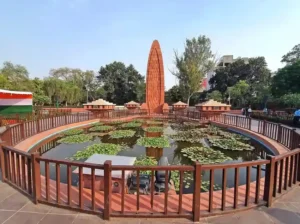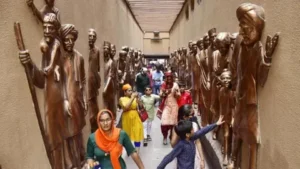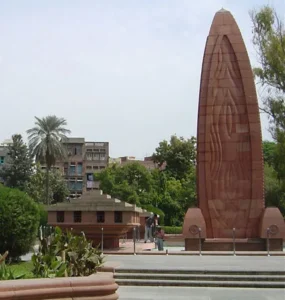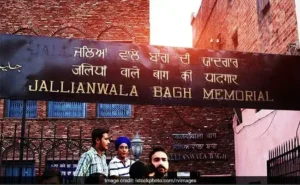Jallianwala Bagh Massacre: “A Turning Point in Indian History″
- The Jallianwala Bagh Massacre, one of the darkest chapters in India’s struggle for independence a poignant reminder of the brutality of British colonial rule.
This Jallianwala Bagh Massacre tragic event occurred on April 13, 1919, in Amritsar, Punjab, during the period of British oppression in India. The massacre, which resulted in the deaths of hundreds of innocent men, women, and children, marked a significant turning point in the Indian freedom movement. To fully understand its impact, it is crucial to explore the background, the events leading up to the massacre, the aftermath, and the legacy it left behind.By the early 20th century, India had been under British colonial rule for nearly two centuries. The British Empire had imposed an economic, social, and political structure that benefitted the colonizers at the expense of the indigenous population.
Background of the Jallianwala Bagh Massacre
British Colonial Rule in India
Despite sporadic uprisings and revolts, the Indian freedom movement had not yet gained significant traction. However, the growing nationalist sentiments, fueled by the Indian National Congress (INC) and the broader freedom movement, began to challenge British dominance.
The First World War (1914–1918)
The First World War played a pivotal role in the unfolding of the Jallianwala Bagh Massacre. During the war, India contributed vast amounts of resources, men, and material to the British war effort. Over a million Indian soldiers fought in various theaters of war, and the economic burden on India was immense. In return for their sacrifices, the Indian populace hoped for political concessions from the British government. Instead, the British responded with repression and martial law.
The Rowlatt Act of 1919
One of the key events leading up to the Jallianwala Bagh massacre was the passing of the Rowlatt Act, also known as the “Anarchical and Revolutionary Crimes Act of 1919.” This law was a draconian measure that allowed the British government to arrest and detain Indians without trial, suppressing political dissent and curbing civil liberties. The Rowlatt Act was seen as a blatant violation of Indian rights and sparked widespread protests across the country. The Indian National Congress, under the leadership of figures like Mahatma Gandhi and Dr. Saifuddin Kitchlew, called for nonviolent resistance against this oppressive law.
The Events Leading to the Massacre
Punjab, where the Jallianwala Bagh massacre occurred, was one of the most politically active regions in British India. Following the passage of the Rowlatt Act, protests erupted throughout the province, with many Indians resisting the repressive measures. The British authorities, already wary of the growing discontent, decided to take strong measures to suppress the agitation.
Protests and Tensions in Punjab
On April 10, 1919, martial law was imposed in Amritsar, and key leaders, including Dr. Saifuddin Kitchlew and Dr. Satyapal, were arrested by the British authorities. The arrest of these leaders led to an escalation in the protests. On April 13, thousands of people gathered in Jallianwala Bagh, a public garden, to peacefully protest the arrests and the Rowlatt Act. The crowd included men, women, and children, many of whom had no idea that the British authorities would respond with such violence.
General Dyer’s Role
Brigadier General Reginald Edward Harry Dyer, the British officer responsible for the Jallianwala Bagh Massacre, was stationed in Amritsar during the protests. Dyer was a staunch believer in the need for strong and forceful measures to maintain British control over India. On April 13, he decided to take action against the gathering in Jallianwala Bagh.
Without any warning, Dyer arrived at the site with 50 soldiers, including armed troops, and ordered them to open fire on the unarmed crowd. The soldiers, under Dyer’s command, continued firing for about ten minutes, until they had expended nearly 1,650 rounds of ammunition. The victims had no means of escape, as the narrow entrance to the park was blocked by the soldiers. The shooting was indiscriminate, with people being shot as they attempted to flee, hid behind trees, or jumped into wells in a desperate attempt to save themselves.
The Aftermath of the Jallianwala Bagh Massacre
Casualties and Destruction
The exact number of casualties from the Jallianwala Bagh massacre remains a subject of debate. Official British reports initially suggested that around 379 people had been killed and over 1,000 wounded. However, subsequent investigations, including those by Indian leaders and independent sources, estimate the death toll to be much higher, with some claiming that more than 1,000 people were killed. The number of wounded is believed to have been in the thousands.
The Jallianwala Bagh Massacre left the entire nation in shock. The British authorities attempted to downplay the severity of the incident, but the brutality of the event could not be hidden. The massacre became a focal point for the growing anger against British rule in India.
Reactions and Protests
The massacre provoked widespread outrage across India and the British colonies. In India, protests erupted in various cities, and nationalist leaders such as Mahatma Gandhi and Jawaharlal Nehru condemned the actions of General Dyer and the British government. Gandhi, who had initially advocated for nonviolent resistance, called for a nationwide hartal (strike) and a boycott of British goods.
In Britain, the reaction was divided. Some British leaders, such as Winston Churchill, condemned the actions of General Dyer, while others, including former British Prime Minister Lord Curzon, defended Dyer’s actions as necessary to maintain order in India. The British Parliament held an inquiry into the incident, but it was criticized for being biased and insufficient.
General Dyer’s Actions and Consequences
General Dyer’s actions were heavily criticized both in India and abroad. Despite the widespread condemnation, Dyer was not immediately removed from his position. In fact, he was hailed by some sections of British society for his “strong leadership” in suppressing the rebellion. However, the backlash against the massacre continued to grow.
In 1920, the British government finally convened an inquiry into the Jallianwala Bagh Massacre. Dyer was found to have acted with excessive force, and he was relieved of his duties, although he never faced any criminal charges. The incident also led to the emergence of the Hunter Commission, which was tasked with investigating the circumstances surrounding the massacre. The commission’s report, while critical of Dyer’s actions, failed to hold him fully accountable for the massacre.
The Legacy of the Jallianwala Bagh Massacre
A Catalyst for Indian Nationalism
The Jallianwala Bagh Massacre had a profound impact on the Indian independence movement. It served as a wake-up call for the Indian population, galvanizing support for the freedom struggle. The brutality of the massacre united people from all walks of life, leading to a surge in nationalist sentiment across the country. The incident also marked a shift in the tactics of the Indian National Congress, with leaders like Gandhi advocating for nonviolent resistance through mass movements like the Non-Cooperation Movement of 1920–1922.
The massacre also contributed to the growing disillusionment with British rule, leading to a more radicalized Indian independence movement. The events at Jallianwala Bagh helped shift the political landscape in India, with younger leaders like Subhas Chandra Bose advocating for more direct confrontation with the British.
Symbol of Sacrifice and Resistance
The memory of Jallianwala Bagh continues to serve as a symbol of resistance and sacrifice for the Indian people. The massacre became a powerful tool in the fight against British colonialism, and it played a crucial role in the eventual achievement of Indian independence in 1947. Today, Jallianwala Bagh stands as a memorial to the victims of the massacre and a reminder of the horrors of colonial oppression.
The site of the massacre in Amritsar has been preserved as a national monument, with a museum and a memorial designed to honor those who lost their lives that day. The Jallianwala Bagh Memorial continues to serve as a site of reflection and remembrance for people across the world.
Jallianwala Bagh Massacre: The Aftermath and Impact on Indian Nationalism (Continued)
The Jallianwala Bagh Massacre was not only a tragic event but also a turning point in the Indian struggle for independence. The brutality of the massacre had profound effects on the Indian nationalist movement and significantly altered the political landscape of colonial India. In this continuation, we will explore the long-term impact of the massacre on India’s independence movement, the consequences faced by the British government, and the influence it had on the future of the Indian struggle.
The Role of Mahatma Gandhi and Non-Cooperation Movement
In the aftermath of the massacre, Mahatma Gandhi’s role as the leader of the Indian National Congress and the freedom struggle became even more pronounced. Gandhi, who had been advocating for non-violent civil disobedience since the early 1900s, used the massacre as a rallying cry for resistance against British rule. Although Gandhi was initially hesitant to fully escalate the situation, the brutality of the Jallianwala Bagh incident led him to call for a nationwide non-cooperation movement.
The Non-Cooperation Movement, which was launched in 1920, was aimed at peacefully resisting British authority through mass nonviolent protests, boycotts of British goods, and non-participation in the British administrative system. The movement gained widespread support across India, as people from all walks of life, including farmers, workers, and students, joined the protests. Gandhi’s philosophy of “ahimsa” (non-violence) became the cornerstone of the movement, and the Jallianwala Bagh Massacre was cited as one of the major injustices that India had suffered under British rule.
The Jallianwala Bagh Massacre also shifted the Indian National Congress (INC) away from constitutional methods of protest toward more direct actions. Before the massacre, the INC had focused on seeking reforms and constitutional changes under British rule, but the massacre revealed the limitations of these methods. As a result, many Congress leaders, including Jawaharlal Nehru, Subhas Chandra Bose, and others, became increasingly disillusioned with British promises of reforms and began to advocate for more direct confrontation. The massacre marked the beginning of a shift in the political approach of India’s freedom struggle, from moderate approaches to more radical demands for independence.
Global Repercussions and British Response
The international community also took note of the Jallianwala Bagh Massacre. News of the horrific event spread globally, and the massacre drew widespread condemnation, particularly from anti-colonial movements and intellectuals. British newspapers were divided in their coverage, with some expressing shock at the brutality, while others, particularly the pro-imperialists, defended General Dyer’s actions.
In the immediate aftermath, General Dyer, who had ordered the massacre, faced little scrutiny from the British government. In fact, he was initially hailed by certain sections of British society for his actions. Some even sent him letters of congratulation for his “bravery.” However, there were others who were appalled by the massacre. In Britain, there were debates in Parliament, and many high-ranking officials, including Winston Churchill, expressed disgust and disappointment at Dyer’s actions.
The British government launched an inquiry into the incident, known as the Hunter Commission, which was set up to examine the circumstances surrounding the massacre. The commission was criticized for its lack of fairness and impartiality. Though it acknowledged that General Dyer had acted with excessive force, the inquiry did not hold him fully accountable for the deaths. Instead, it blamed local authorities for the unrest and absolved the British government of any significant responsibility. This further deepened the sense of injustice among the Indian people.
Despite the official inquiry, the British government did not punish Dyer, and he was allowed to return to Britain as a hero to some. He even received a pension from the British government for his services. This inability of the British authorities to hold Dyer accountable only fueled the resentment against colonial rule and added to the anger and determination of Indian nationalists to fight for independence.
The Jallianwala Bagh Memorial and Its Significance
The memory of the Jallianwala Bagh Massacre continues to live on in the hearts and minds of millions of Indians. The site of the massacre, Jallianwala Bagh, has been transformed into a national memorial and stands as a symbol of the resilience and sacrifice of those who lost their lives on that fateful day.
The Jallianwala Bagh Massacre Memorial was constructed in 1951 by the Government of India, and it includes a well, which is believed to have been the site where many people jumped to escape the gunfire. The Memorial has a commemorative plaque, a museum, and a gallery that preserves the history of the event. The memorial is visited by thousands of people each year, including leaders, historians, and ordinary citizens who come to pay their respects to the martyrs.
The monument is a symbol of India’s resistance to British colonialism and serves as a reminder of the sacrifices made by the people of India in their fight for freedom. The incident continues to inspire movements for justice and human rights across the globe, with its lessons of non-violence and resistance against oppression serving as a beacon for future generations.
The Role of Sikhism in the Jallianwala Bagh Massacre
While the massacre affected all Indians regardless of their religion, it had a particularly profound impact on the Sikh community. Punjab, where the massacre took place, was predominantly Sikh, and the brutal killings only intensified their anger toward the British. The massacre was seen by many Sikhs as an attack on their community, as many of the victims in Jallianwala Bagh were Sikh men and women.
The impact of the massacre on the Sikh community was far-reaching. The incident made the Sikh population more determined to resist British rule. It was also a key moment in the rise of Sikh nationalism, with calls for greater autonomy and representation. In subsequent years, many Sikh leaders played an important role in India’s independence movement, using the Jallianwala Bagh massacre as a symbol of their struggle against British oppression.
National and International Reverberations
The Jallianwala Bagh Massacre echoed beyond India’s borders and became a rallying point for anti-colonial movements around the world. In countries like Ireland, South Africa, and Egypt, the massacre was seen as evidence of the British Empire’s cruelty and disregard for human life. The massacre further solidified the image of British imperialism as a force that oppressed and exploited its colonies.
The massacre, along with other incidents of colonial violence, helped fuel global movements for independence, particularly in other British colonies. The massacre highlighted the fundamental injustices that underpinned British colonial rule, and it spurred growing resistance from marginalized communities in the British Empire.
The Legacy and Impact on Indian Independence
The Jallianwala Bagh Massacre had a long-lasting impact on India’s path to independence. In the years following the massacre, India witnessed a shift in the nature of the nationalist movement. While the movement had initially been characterized by moderate demands for constitutional reforms, the massacre led to a more radical, mass-based movement calling for complete independence (Purna Swaraj) from British rule.
The massacre served as a significant catalyst for the rise of new political leaders who were willing to confront British rule more aggressively. The Indian National Congress, under the leadership of Mahatma Gandhi, launched the Non-Cooperation Movement in 1920, a nationwide campaign of passive resistance aimed at weakening British authority. The massacre’s legacy also inspired later movements, including the Salt March in 1930 and the Quit India Movement in 1942, both of which mobilized millions of Indians in nonviolent resistance against British colonialism.
India eventually gained independence in 1947, but the lessons learned from the Jallianwala Bagh Massacre continued to shape the political and social landscape of the country. The massacre not only acted as a catalyst for the Indian independence movement but also set the stage for the global struggle for human rights, justice, and freedom.
Conclusion
The Jallianwala Bagh Massacre of 1919 was a turning point in the history of India’s struggle for independence. The brutal actions of General Dyer and the British authorities served as a wake-up call for the Indian populace, uniting them in their fight for freedom. The massacre’s legacy continues to shape the national consciousness, serving as a reminder of the sacrifices made by countless individuals in the pursuit of justice and independence. It remains one of the most significant and tragic events in Indian history, one that galvanized the country’s struggle for self-rule and left an indelible mark on the nation’s path toward independence.
As a symbol of sacrifice, resistance, and national unity, the Jallianwala Bagh Massacre continues to serve as a powerful reminder of the importance of freedom, justice, and human dignity. Its legacy, intertwined with the broader struggle for independence, continues to inspire generations of Indians and people around the world to stand against injustice and fight for a better future.
‘,’
‘ ); } ?>
Table of Contents




